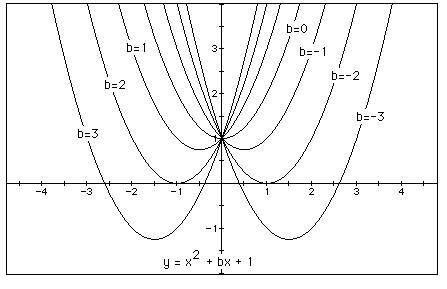

Last modified on August
20, 1998.
The attached 4-page paper is the start
of an article that might appear in a journal such as the Mathematics
Teacher -- the audience being mathematics teachers who
might use some of the ideas for instruction.
It is a start; incomplete, unclear, maybe in error; maybe glossing
over significant points and stressing some obvious or trivial
points.
Your assignment:
Sign on as a co-author. Rewrite and complete the article.
This means you must come to grips with whatever points are to
be essential, what to add, what to delete, and what to edit. The
"different" approaches to this topic are really in the
graphs in the xb, xc, or xa planes. You might
want to examine a bunch of these before trying to re-write.
It has now become a rather standard exercise, with availble
technology, to construct graphs to consider the equation
and to overlay several graphs of
for different values of a, b, or c as the other two are held
constant. From these graphs discussion of the patterns for the
roots of
can be followed. For example, if we set
for b = -3, -2, -1, 0, 1, 2, 3, and overlay the graphs, the
following picture is obtained.

We can discuss the "movement" of a parabola as b
is changed. The parabola always passes through the same point
on the y-axis ( the point (0,1) with this equation). For b <
-2 the parabola will intersect the x-axis in two points with positive
x values (i.e. the original equation will have two real roots,
both positive). For b = -2, the parabola is tangent to the x-axis
and so the original equation has one real and positive root at
the point of tangency. For -2 < b < 2, the parabola does
not intersect the x-axis -- the original equation has no real
roots. Similarly for b = 2 the parabola is tangent to the x-axis
(one real negative root) and for b > 2, the parabola intersets
the x-axis twice to show two negative real roots for each b.
Now consider the locus of the vertices of the set of parabolas
graphed from
Show that the locus is the parabola:
By using the general equation to determine a, for the focus (0,a), 4a = -1. Negative 1 being the coefficient of x^2. A = -1/4; adding 1 results in a = 3/4. The focus = (0,.75) and the directrix is y = 1.25 since the vertex is equidistant from the focus and the directrix.

Consider the equation
This relation will be graphed in the xa plane:


For each value of a we select, we get a horizontal line. It is clear on a single graph that we get one negative real root of the original equation when a >0 and one positive real root when a < 0.
Consider again the equation
Now graph this relation in the xb plane. We get the following
graph.

If we take any particular value of b, say b = 5, and overlay
this equation on the graph we add a line parallel to the x-axis.
If it intersects the curve in the xb plane the intersection points
correspond to the roots of the original equation for that value
of b. We have the following graphs. Note that the values of the
roots are given (where y = b):




In the following example the equation
is considered. If the equation is graphed in the xc plane,
it is easy to see that the curve will be a parabola. For each
value of c considered, its graph will be a line crossing the parabola
in 0, 1, or 2 points -- the intersections being at the roots of
the orignal equation at that value of c. In the graph, the graph
of c = 1 is shown. The equation
will have two negative roots -- approximately -0.2 and -4.8.


There is one value of c where the equation will have only 1
real root -- at c = 6.25. For c > 6.25 the equation will have
no real roots and for c < 6.25 the equation will have two roots,
both negative for 0 < c < 6.25, one negative and one 0 when
c = 0 and one negative and one positive when c < 0.